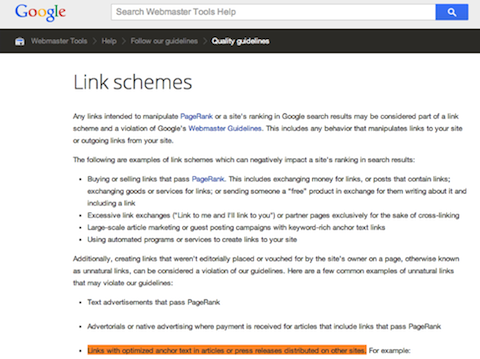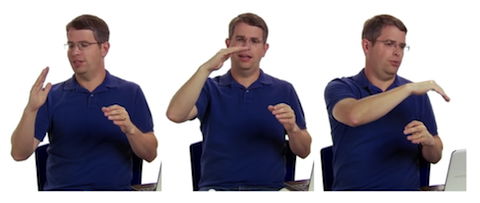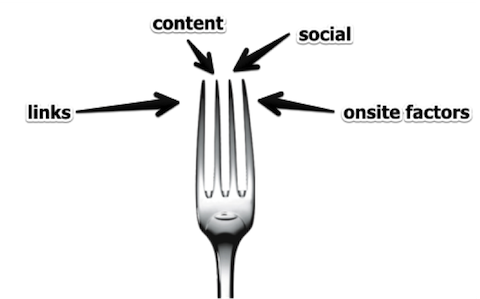
By Neil Patel, from Quick Sprout – http://bit.ly/1gdGwwC
When you’re doing your site’s SEO, you have to be careful. The techniques that used to work will now get you penalized. The techniques that used to be a waste of time are now indispensable.
Now and then, we need to be reminded what works and what doesn’t. As it stands today, there are five SEO techniques that I need to warn you about. These techniques could be hurting your site.
Technique #1: Spammy Guest Blogging
Earlier this year, Matt Cutts came out with an announcement that sent tremors through the web community:
If you’re using guest blogging as a way to gain links in 2014, you should probably stop.
Here’s what happened after he published that blog post: Mayhem. Unleashed.
Guest blogging has been a pillar of content strategists and SEOs for a long time. Was Cutts really pulling the plug on the practice?
Yes and no.
The fact is not a single line of algorithmic code was changed when Cutts clicked “publish” on his post. The panic was overrated. The people who should be scared are the people who are sending emails to me and Cutts asking for guest posts so they can pop in a backlink.
That’s why Cutts rattled his saber against guest blogging. The spammy SEOs had once again twisted a good thing — guest blogging — into a black hat technique.
There is legitimate guest blogging, and then there is spammy guest blogging. I’m a major fan of guest blogging, and I still recommend that you practice it, but with caution.
Since guest blogging got the hairy eyeball from Cutts, I think the algorithm will shift to start suppressing spammy guest blogging results. Here’s what the change might look like:
- First, Google will crack down on guest post links that are irrelevant to the site’s theme. For example, you think an auto insurance sales links on forbes.com/technology is a good idea? Not going to happen.
- Second, Google will tighten the penalties on optimized anchors in guest posts. Optimized anchors are always bad, but it’s likely that the penalties will be swifter and harsher on those that appear in guest blogs.
- Third, Google will increase the algorithmic importance of Google authorship and authority. This is a critical determining factor already. It’s important to keep a pulse on it. In order to look at your own metrics, go to Google Webmaster Tools > Labs > Author Stats. Your personal authority as an author will have an increasing importance upon the validity of your guest blogging.
And if you’re doing any of the following with your guest blogging, I recommend that you stop.
- Using optimized anchors (more on that below) in your guest posts
- Attempting to rank for long tail keywords in your guest posts
- Attempting to rank for head terms in your guest posts
- Writing irrelevant content in your guest posts
- Writing low-quality content in your guest posts
Right now, guest blogging is still a viable option for improving SEO, enhancing brand awareness, and even building your author rank. However, you need to be extremely careful how you execute your guest blogging plan.
Bottom line: Use guest blogging with caution.
Pro Tip: If you do decide to explore guest blogging, my friends at Hunter recently published an in-depth article talking about writing guest post pitches that convert. You can find helpful tips on how to write an effective guest post pitch written by professionals whose guest posts were published on SEMRush, WordStream, and MarketingProfs.
Technique #2: Optimized Anchors
For a long time, SEOs used anchor texts with keywords to improve their SEO. The great thing was it worked! But the days of optimized anchors are gone. Today, using optimized anchors is like asking for a penalty.
So what’s an optimized anchor? An optimized anchor is an anchor text that uses keywords for which you want to rank. For example, if a site wants to rank for the term “top mobile phone,” it would use the anchor “top mobile phone” to link to its mobile phone site.
It worked great until Google warned against this practice in its “Link Scheme” document.

The text reads:
Here are a few common examples of unnatural links that may violate our guidelines…
Links with optimized anchor text in articles or press releases distributed on other sites. For example:
There are many wedding rings on the market. If you want to have a wedding, you will have to pick the best ring. You will also need to buy flowers and a wedding dress.
In other words, don’t optimize anchor texts. I’ve seen optimized anchor texts ruin a site’s SEO through gradual algorithmic penalization. The best I can say about it is that it’s extremely risky.
I know what you are thinking, “Well, what kind of anchors do I use?”
That’s a great question. There are several types of safe anchors that I recommend:
- Naked URLs like this one: www.quicksprout.com
- Branded URLs like this one: For more advice on content marketing, check Quicksprout.
- Long phrases like this one: I’m a major fan of guest blogging, and I still recommend that you practice it with caution.
Links are still important, but their SEO value has more to do with their mere existence than it does with their anchor text.
Bottom line: Use safe anchors, not optimized anchors.
Technique #3: Quantity of links over quality
The more backlinks your site gets, the better, right?
No.
Purchasing backlinks is quick, easy, and pretty cheap. You can find any number of SEO agencies who will build a bunch of links for you. In the course of a week or two, they can pile up a few dozen links pointing directly at the pages you specify.
But that could ruin your site, especially if the following is true:
- The site that links is penalized.
- The site that links has a low DA (e.g. below DA 20).
- You receive a large number of such links in a short period of time.
Link building has been and still is the bread and butter of many SEO agencies. However, any SEO value from link building depends upon the authority and validity of the site that is sending the links.
Here’s a quick example. I watched this site languish under a shoddy SEO campaign for months. The SEOs employed by the company were drumming up quick and easy links like crazy. It hurt. Then, when they engaged in an aggressive content marketing campaign with an SEO upside, things changed:

The uptick coincided with a very small number of high-DA backlinks (2 DA 90+ links). The decline coincided with the deluge of low DA backlinks.
Bottom line: Link building is still alive and well, but don’t try to do it with lots of low-DA backlinks. There is a better way.
Technique #4: Keyword Heavy Content
It’s old news that keyword stuffing is bad. This is one of the earliest tricks in the SEO playbook.
Here’s how Google defines keyword stuffing:
“Keyword stuffing” refers to the practice of loading a webpage with keywords or numbers in an attempt to manipulate a site’s ranking in Google search results. Often these keywords appear in a list or group, or out of context (not as natural prose). Filling pages with keywords or numbers results in a negative user experience, and can harm your site’s ranking. Focus on creating useful, information-rich content that uses keywords appropriately and in context.
In spite of the of warnings and consequences of keyword stuffing, I still see it happen.
Here is how Matt Cutts, in a 2011 video, illustrated the effect of adding more and more keywords. Up – plateau – down.

It’s like a bell curve. Add a keyword or two, and you’ll gain some rank. Keep adding keywords, and it doesn’t really add much rank benefit. Keep adding keywords, and you’ll start to lose rank.
In other words, keyword stuff and get penalized.
I want to add something new to this discussion rather than just give you the same worn out warnings. Here are four pieces of advice that will help you avoid keyword-heavy content and produce penalty-free content.
- The kind of keyword stuffing that gets penalized is long tail keywords rather than head terms. For example, “San Francisco hotel vacation cheap” is a long tail keyword. Drop that in your content a few too many times, and a penalty isn’t far behind. However, if you have to use the term “San Francisco” quite a few times, that’s okay.
- Add more content, not just more keywords. The most important thing about keywords is not how many times they occur. I recommend adding more content — both the number of posts and the length of that content. The more pages you have, the more pages on your site will be indexed. When you have lengthy and substantial content on those pages, you’ll have more reader-focused material and related terms.
- Don’t worry about keyword density. Instead, worry about creating really good content for your readers. There was a time when “keyword density” was a big deal. In fact, many SEO writers actually had to run keyword density analyses on their content to make sure that they were in the correct density percentage range. Your goal instead is to shape content for your readers, not the search engines.
- Use related keywords. There’s been some confusion (and change) over the use of latent semantic indexing (LSI) with Google. Whatever Google’s current use of LSI, keep in mind that related keywords are important for both avoiding keyword stuffing and improving your search results. For example, instead of using “San Francisco hotel vacation cheap” a dozen times, you would include natural phrases like “places to stay in the Bay Area” or “lodging near Union Square.”
Bottom line: Go easy on the long tail keywords. Instead, publish more articles with longer content.
Technique #5: Relying on link-backs instead of content
Link-backs, while important, are not the only component of SEO. There is a delusion that merely throwing a lot of links to a site will magically bring massive authority, high rankings, and tons of search traffic.
That’s simply not the case.
Truly effective SEO is about the sum of several parts — not one or two techniques pushed to the extreme.
Think about SEO as if it were a fork. A fork doesn’t work if it has just a single tine. A one-tine fork is a spear. A two-tine fork doesn’t work either. Effective forks have several tines — usually four.
SEO is the same way. In order to be effective, you have to use all four components of SEO:

Links are just part of the solution, not the whole thing. You can rack up a huge link profile, but unless you’re advancing your efforts with content marketing, social signals, and solid onsite optimizing (site speed, UI, etc.), you’re wasting your time and money.
Bottom line: Use a link-back strategy, but keep it balanced with the entire suite of SEO — content marketing, social media, and onsite optimization.
Conclusion
SEO isn’t about the latest tricks or techniques. It’s a long-term strategy that takes into account all relevant factors.
This article provides some much-needed warnings. It’s time to back off the gimmicks that you thought would work. SEO is not dead, but it has changed. You need to adapt your strategy accordingly.
What are some of the things you’ve done that have either hurt or helped your SEO? Leave a comment below.
